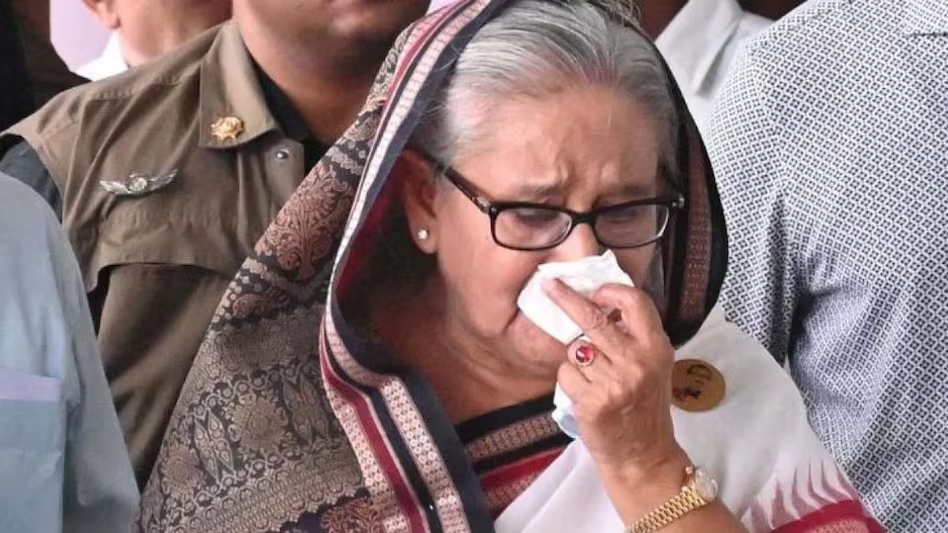The tale of Sheikh Hasina took a dramatic turn recently, as the long-standing leader of Bangladesh was ousted amidst widespread riots and political turmoil. Facing intense pressure and unprecedented unrest, Hasina resigned from her position and fled to India, seeking refuge from the chaos engulfing her homeland. This unexpected twist marks a significant chapter in her storied political career, raising questions about the future of Bangladesh and the legacy of its most controversial leader.
Sheikh Hasina’s life is not just one of personal resilience but also a vivid depiction of Bangladesh’s turbulent history. Born into a family of political turmoil, her life was shaped by both profound loss and relentless ambition. Today let’s explore her remarkable journey, from childhood through her rise to power, and her recent ousting.
Sheikh Hasina was born in 1947, in Gopalganj, East Pakistan (now Bangladesh), into a family destined for political greatness. As the eldest of five children, her early years were marked by the frequent absence of her father, Sheikh Mujibur Rahman, who spent a significant amount of time in prison due to his political activities. These experiences shaped young Hasina’s perspective on leadership and resilience.
In school, Hasina demonstrated her defiance early on. Her disagreement with the narrative in her social studies textbooks about Pakistani leaders led her to write her own version of history during exams, a move that cost her marks but highlighted her strong principles. She was already showing signs of the resolute leader she would become.
On the fateful night of August 15, 1975, Sheikh Mujibur Rahman, the then-President of Bangladesh, and most of his family were brutally murdered in a military coup. The scene was nothing short of horrific, with Mujib being shot multiple times in his own home. Only Sheikh Hasina and her sister Sheikh Rehana survived, as they were abroad in Germany at the time.
The news of her family’s massacre was delivered to Hasina by Bangladesh’s ambassador in Germany. This event marked a turning point in her life, pushing her into a period of exile and grief. But it also ignited a burning desire to avenge her family and restore their legacy.
Read more: Matrix Trump dodges bullet, invokes meme mayhem at RNC rally
Sheikh Hasina’s Exile and Political Comeback
Living in exile in India, Hasina and her family were taken under the wing of Indian Prime Minister Indira Gandhi, who provided them with a safe haven. Adopting new names and living in secrecy, Hasina continued to champion her father’s legacy from afar. Her return to Bangladesh in 1981 marked a pivotal moment. Elected as the president of the Awami League in absentia, she returned to a hero’s welcome, with thousands of supporters lining the streets.
However, her return wasn’t without danger. Hasina faced numerous assassination attempts and was frequently put under house arrest. Her resilience only grew stronger, leading her to mobilise a broad coalition against the military regime, particularly after the brutal student crackdown at Dhaka University in 1983.
Political Struggles and Leadership
The 1980s and 90s were tumultuous for Hasina. She constantly battled military leaders and rival politicians, particularly Khaleda Zia of the Bangladesh Nationalist Party (BNP). The rivalry reached a peak in the 1990s, with both women alternating in power and each accusing the other of corruption and political manipulation.
Despite the political instability, Hasina’s tenure saw significant achievements. Her first term as Prime Minister, beginning in 1996, was marked by landmark agreements like the Ganges Water Treaty with India and efforts to quell insurgencies. However, she also faced severe criticism for alleged authoritarian practices and failure to maintain democratic norms due to which she lost the next elections.
After a crushing defeat in 2001, Hasina didn’t retreat. She used her time in opposition to rally support, emphasising grassroots mobilisation and maintaining pressure on the ruling BNP. The political scene in Bangladesh remained volatile, with continuous allegations of corruption and electoral fraud from both sides.
In 2006, the political impasse between Hasina and Zia led to the declaration of a state of emergency. During this period, Hasina faced corruption charges and was temporarily barred from returning to Bangladesh. However, her unwavering determination saw her return and eventually triumph in the 2008 elections, leading to consecutive terms in office.
Read more: Julian Assange’s great escape
Bangladesh’s Economic Growth
Bangladesh’s economic journey over the past few decades is nothing short of extraordinary. Emerging from the shadows of war, political upheaval, and natural disasters, the country has charted a course of impressive economic growth. This transformation has positioned Bangladesh as a rising star in Asia, with remarkable progress in various sectors. Here’s a closer look at the factors driving this growth and the challenges that lie ahead.
Historical Context: From Struggle to Stability
Bangladesh was born in 1971 out of the ashes of a brutal liberation war against Pakistan. The initial years were fraught with challenges, including political instability, natural disasters, and widespread poverty. The country was often dismissed as a “basket case” by global observers. However, the resilience of its people and strategic policy shifts over the years have turned the tide.
Key Drivers of Economic Growth
1. The Ready-Made Garment (RMG) Industry:
The RMG sector has been the cornerstone of Bangladesh’s economic growth. Starting in the late 1970s, the industry has grown exponentially, making Bangladesh the second-largest garment exporter in the world, after China. The sector employs millions of workers, predominantly women, providing a significant boost to the economy and contributing to social change by empowering women.
2. Microfinance and Social Entrepreneurship:
The advent of microfinance, spearheaded by institutions like Grameen Bank and BRAC, has played a pivotal role in poverty alleviation. These institutions have provided millions of small loans to the poor, enabling them to start businesses, improve their living standards, and contribute to the economy. The success of microfinance in Bangladesh has become a model for the world.
3. Agricultural Productivity:
Agriculture remains a vital sector for Bangladesh, employing a significant portion of the population. Innovations in agricultural techniques, increased use of fertilizers, and improved irrigation have led to higher yields and food security. The government’s efforts to support farmers through subsidies and research have also paid dividends.
4. Remittances:
The Bangladeshi diaspora, particularly in the Middle East, has been a crucial source of foreign exchange. Remittances from expatriate workers have provided a steady inflow of funds, bolstering the country’s foreign reserves and contributing to economic stability.
5. Government Policies and Reforms:
Successive governments have implemented policies aimed at liberalizing the economy, improving infrastructure, and attracting foreign investment. The creation of export processing zones (EPZs) and the promotion of a business-friendly environment have been significant in attracting foreign direct investment (FDI).
Social Indicators: Education and Healthcare
Economic growth in Bangladesh has been accompanied by notable improvements in social indicators. The government and various non-governmental organizations (NGOs) have made concerted efforts to enhance education and healthcare.
1. Education:
Bangladesh has made impressive strides in improving literacy rates and achieving gender parity in education. Primary and secondary school enrolment rates have increased significantly, thanks to government initiatives like free textbooks and stipends for female students. These efforts have created a more educated workforce, ready to contribute to the economy.
2. Healthcare:
Public health initiatives have led to a significant decline in infant mortality rates and increased life expectancy. Programs targeting maternal health, vaccination drives, and the provision of basic healthcare services have had a profound impact on public health.
Ousting and Legacy
In recent years, Hasina’s grip on power has faced increasing challenges. The reinstatement of job quotas for war veterans by the High Court, amidst widespread protests and violence, symbolised the growing discontent. The Supreme Court’s intervention to reduce the quotas was not enough to quell the unrest, ultimately leading to Hasina’s resignation amidst intense pressure and unrest.
Her legacy is a complex one. On the one hand, she has been credited with significant economic advancements and maintaining civilian rule in a country with a history of military coups. On the other hand, her tenure has been marred by allegations of autocracy and suppression of opposition.
Sheikh Hasina’s journey is a testament to resilience and determination in the face of unimaginable personal and political challenges. Her story, marked by tragedy and triumph, continues to be a defining chapter in Bangladesh’s history. As she steps down, the country faces an uncertain future, but her impact on its political and economic landscape is undeniable. Whether history will view her more as a protector of her father’s legacy or as a controversial figure remains to be seen, but one thing is certain: Sheikh Hasina’s story is far from over.
What’s happening in Bangladesh?
Student Protests and Demands:
Initial Demand: The protests began in late June with students demanding the abolition of a quota system that reserved up to 30% of government jobs for relatives of veterans who fought in Bangladesh’s war of independence in 1971 against Pakistan.
Peaceful Demonstrations: Initially, students demonstrated peacefully, but tensions escalated when they were attacked by individuals affiliated with the ruling Awami League party.
Wider Civil Disobedience: The protests swelled into a broader civil disobedience movement, with people of all ages joining in. They now demand accountability from the government and the resignation of Prime Minister Sheikh Hasina.
Government’s Actions:
Initial Abolition: In 2018, the government abolished all job quotas, including the freedom fighters’ quota, following large-scale student agitation.
High Court Reinstatement: However, in June 2024, the High Court reinstated the 30% quota system after a petition by relatives of war veterans.
Supreme Court Order: Amidst the protests, the Supreme Court issued an order to reduce the quota from 30% to 5%.
Current Situation:
Violence and Crackdown: The protests led to clashes, curfews, and internet shutdowns. Authorities attacked protesters, resulting in deaths and injuries.
Ongoing Unrest: The situation remains tense, with protesters continuing their demands for quota reforms and government accountability.
In summary, students want a merit-based system, while the government has reinstated quotas, leading to widespread protests and violence. The issue remains contentious, affecting both job opportunities and social stability in Bangladesh



